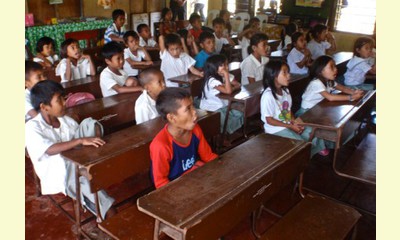|
|
Philippines: Schools of Peace: Antidote to culture of war, violence
un article par United Nations Development Program, Philippines (abridged)
Manila de Bugabos, Agusan del Norte – Joy Carol C.
Ardecer teaches peace to Grade 1 pupils.

School children in the ‘School of Peace’ in Manila de Bugabos, Agusan del Norte are taught about peace. (Photo: MP Duran/ UNDP Philippines)
click on photo to enlarge
This morning, the lesson plan in mathematics was
about time. "Peace is not just the absence of
violence," she explains. "Punctuality, for instance,
is an important component of peace."
After the lesson, the children sing: "God answers
prayers in the morning… at noon… in the evening. So
let’s pray…"
"When do we have peace?" Ardecer asks. "When we
pray," the pupils reply.
"The song inspires inner peace," she says. "It’s all
part of the School of Peace curriculum."
Until the early 1980s, Manila de Bugabos was often a
battleground between government soldiers and
communist guerrillas. An hour’s drive from Butuan
City, it is accessible only by a footbridge when the
river is swollen by heavy rains.
Last year, it declared itself a Peace and
Development Community promoted in 20 of 24
Mindanao provinces by the Action for Conflict
Transformation (ACT) for Peace Program. Until ACT
constructed a potable water system, residents used
to trek four kilometers to get drinking water. ACT
has also put in place a Botika ng Barangay and a
Barangay Development Plan.
A government enterprise supported by Australia, New
Zealand, Spain, the European Union and the United
Nations Development Program, ACT helped develop
peace-based lessons plans up to college.
To strengthen peace-building in communities
affected by hostilities or vulnerable to
conflicts, ACT hopes to dismantle a culture of war
by integrating peace principles, concepts and
values in 53 Schools of Peace it has created in
Mindanao, including that in Manila de Bugabos.
The lesson plans were developed at the J. Marquez
School where thousands of separatist rebels were
billeted after signing a peace agreement with the
government in 1997. It was then that the school
was declared the flagship school of peace.
The elementary lesson plan used by Ardecer took
three years to develop. It was written by 36
teachers, reviewed by 18 of their peers and 12
consultants and a 10-member technical working
group from North Cotabato, Lanao del Norte, Lanao
del Sur, Maguindanao and Sultan Kudarat.
Science, mathematics and Filipino and English
communication arts integrate peace and Islamic
values in the belief that children exposed to an
environment of peace stand a better chance than
those marred by violence and abuses.
Peace often assumed in the absence of war does not
paint an accurate picture, the lesson plans note
in a guide for teachers: "Silence, after all,
might not only mean calm or order. It can also be
characterized by fear, which is prevalent in
communities living under threat of armed
confrontation between rebel groups or other
lawless elements and the army."
"Peace as marked by the decline in armed violence
does not bring into focus the casualties of
poverty, cultural discrimination or
marginalization, political repression and
environmental destruction which are not as
deafening as wars but have graver impact" . . .
|








|
DISCUSSION
Question(s) liée(s) à cet article:
What is the latest update on the peace situation in Mindanao?,
* * * * *
Commentaire le plus récent:
The agreement of October 15 2012 has given rise to optimism, but many problems remain. For a typical analysis see that of The Economist.
The Philippines' Southern Insurgency
It could be peace
Hopes grow for an end to a bloody and long-running insurgency
AFTER 16 years of on-and-off negotiations, the Philippines government and the main Muslim rebel group in the southern region of Mindanao, the Moro Islamic Liberation Front, agreed to the outlines of a peace deal on October 6th. The two sides are due to sign it formally on October 15th. If it works, which is far from guaranteed, it could bring an end to more than four decades of fighting by armed Muslims seeking independence from the mainly Christian archipelago nation. The Mindanao conflict has killed perhaps 120,000 people and displaced 2m more. Mindanao is home to most of the country’s Muslims, who make up about 5% of the population of about 100m.
The agreement is not a final peace deal, but rather what President Benigno Aquino describes as “a framework agreement” and the front calls a “road map”. Yet both sides believe that it paves the way for what Mr Aquino hopes will prove “a final, enduring peace” in Mindanao.
The peace plan envisages the establishment of an autonomous Muslim area in Mindanao, called Bangsamoro, subject to a plebiscite there. The proposed Bangsamoro will have budgetary autonomy and a just share of revenues from the extraction of southern resources; its own police force; and sharia law for Muslims only. . ... continuation.

|
|









